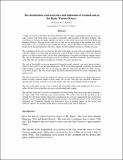| dc.description.abstract | The examination of the soils revealed that the soils of the upper sections of Sio are imperfectly drained
to poorly drained, very deep, dark grayish brown to black, friable to firm, sandy clay to clay. The top
topsoil is in places humic with a 20 cm thick undecomposed or partially decomposed organic matter.
The soils are developed on various igneous rocks or colluvial and alluvial materials derived from these
rocks. The soils are classified as Cambisols, Vertisols, Planosols and Gleysols.
The soils of the middle section are imperfectly drained to poorly drained, very deep, brown to black,
friable to firm, sand to clay. In undisturbed areas, 20-30 cm of undecomposed or partially decomposed
organic matter occurred. The soils are classified as Gleysols, Arenosols and Fluvisols while Acrisols
occur on the fringes. The soils are developed on alluvial material derived from various sedimentary and
igneous rocks.
The soils of the lower section are imperfectly drained to very poorly drained, very deep, dark grayish
brown to black, mottled, friable to firm, sandy clay to clay. The soils are classified as Fluvisols,
Gleysols and Vertisols. Acrisols occur on the fringes. The soils are developed on alluvial material.
The soils of the upper section occur in valleys and bottomlands while in the middle part they occur in
valleys. In the lower section the soils occur in bottomlands and swamps.
The wetlands in the three sections are dominantly used for growing subsistence crops and for grazing at
the edges while other utilizations are section specific. The results show that the opening up of a
wetland for cultivation without taking into consideration the necessary management and conservation
measures (in the wetland and the adjacent uplands), reduces the buffering capacity of the wetland with
continued use. Vegetation clearing was observed to have a negative impact on the sieving and
buffering capacity of a wetland mainly due to siltation and organic matter depletion. | en_US |

